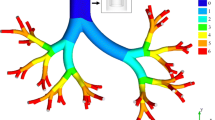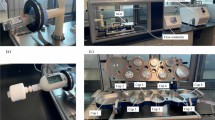ABSTRACT
Purpose
The objective of this study is to evaluate the effects of enhanced condensational growth (ECG), as a novel inhalation drug delivery method, on nano-aerosol deposition in a mouth-throat (MT) and upper tracheobronchial (TB) model using in vitro experiments and computational fluid dynamics (CFD) simulations.
Methods
Separate streams of nebulized nano-aerosols and saturated humidified air (39°C—ECG; 25°C—control) were combined as they were introduced into a realistic MT-TB geometry. Aerosol deposition was determined in the MT, generations G0-G2 (trachea—lobar bronchi) and G3-G5 and compared to CFD simulations.
Results
Using ECG conditions, deposition of 560 and 900 nm aerosols was low in the MT region of the MT-TB model. Aerosol drug deposition in the G0-G2 and G3-G5 regions increased due to enhanced condensational growth compared to control. CFD-predicted depositions were generally in good agreement with the experimental values.
Conclusions
The ECG platform appears to offer an effective method of delivering nano-aerosols through the extrathoracic region, with minimal deposition, to the tracheobronchial airways and beyond. Aerosol deposition is then facilitated as enhanced condensational growth increases particle size. Future studies will investigate the effects of physio-chemical drug properties and realistic inhalation profiles on ECG growth characteristics.







Similar content being viewed by others
Abbreviations
- CFD:
-
computational fluid dynamics
- DPI:
-
dry powder inhaler
- ECG:
-
enhanced condensational growth
- G:
-
generation
- MDI:
-
metered dose inhaler
- MT:
-
mouth-throat
- SD:
-
standard deviation
- TB:
-
tracheobronchial
REFERENCES
Borgstrom L, Olsson B, Thorsson L. Degree of throat deposition can explain the variability in lung deposition of inhaled drugs. J Aerosol Med. 2006;19:473–83.
Newman SP. A comparison of lung deposition patterns between different asthma inhalers. J Aerosol Med. 1995;8 Suppl 3:S21–26. discussion S27.
Leach CL, Davidson PJ, Bouhuys A. Improved airway targeting with the CFC-free HFA-beclomethasone metered-dose inhaler compared with CFC-beclomethasone. Eur Respir J. 1998;12:1346–53.
Smaldone GC. Advances in aerosols: adult respiratory disease. J Aerosol Med. 2006;19:36–46.
Byron PR. Drug delivery devices: issues in drug development. Proc Am Thorac Soc. 2004;1:321–8.
Longest PW, Hindle M, Das Choudhuri S, Byron PR. Developing a better understanding of spray system design using a combination of CFD modeling and experiment. In: Dalby RN et al., editors. Proceedings of Respiratory Drug Delivery 2008. Illinois: Davis Healthcare International; 2008. p. 151–63.
Hindle, M. Soft mist inhalers: a review of current technology. The Drug Delivery Companies Report Autumn/Winter. 2004;31–4.
Cheng YS, Fu CS, Yazzie D, Zhou Y. Respiratory deposition patterns of salbutamol pMDI with CFC and HFA-134a formulations in a human airway replica. J Aerosol Med. 2001;14:255–66.
Longest PW, Hindle M, Das Choudhuri S, Xi J. Comparison of ambient and spray aerosol deposition in a standard induction port and more realistic mouth–throat geometry. J Aerosol Sci. 2008;39:572–91.
Zhang Y, Gilbertson K, Finlay WH. In vivo-in vitro comparison of deposition in three mouth-throat models with Qvar and Turbuhaler inhalers. J Aerosol Med. 2007;20:227–35.
Xi J, Longest PW. Effects of oral airway geometry characteristics on the diffusional deposition of inhaled nanoparticles. ASME J Biomech Eng. 2008;130:011008.
Cheng YS. Aerosol deposition in the extrathoracic region. Aerosol Sci Tech. 2003;37:659–71.
Card JW, Zeldin DC, Bonner JC, Nestmann ER. Pulmonary applications and toxicity of engineered nanoparticles. Am J Physiol Lung Cell Mol Physiol. 2008;295:L400–411.
Sung JC, Pulliam BL, Edwards DA. Nanoparticles for drug delivery to the lungs. Trends Biotechnol. 2007;25:563–70.
Cohen BS, Sussman RG, Lippmann M. Ultrafine particle deposition in a human tracheobronchial cast. Aerosol Sci Tech. 1990;12:1082–93.
Jaques PA, Kim CS. Measurement of total lung deposition of inhaled ultrafine particles in healthy men and women. Inhal Toxicol. 2000;12:715–31.
Morawska L, Hofmann W, Hitchins-Loveday J, Swanson C, Mengersen K. Experimental study of the deposition of combustion aerosols in the human respiratory tract. J Aerosol Sci. 2005;36:939–57.
Stahlhofen W, Rudolf G, James AC. Intercomparison of experimental regional aerosol deposition data. J Aerosol Med. 1989;2:285–308.
Pandey R et al. Poly (DL-lactide-co-glycolide) nanoparticle-based inhalable sustained drug delivery system for experimental tuberculosis. J Antimicrob Chemother. 2003;52:981–6.
Dickinson PA, Howells SW, Kellaway IW. Novel nanoparticles for pulmonary drug administration. J Drug Target. 2001;9:295–302.
Azarmi S, Roa WH, Lobenberg R. Targeted delivery of nanoparticles for the treatment of lung diseases. Adv Drug Deliv Rev. 2008;60:863–75.
Nyambura BK, Kellaway IW, Taylor KMG. Insulin nanoparticles: stability and aerosolization from pressurized metered dose inhalers. Int J Pharm. 2009;375:114–22.
Ferron GA. The size of soluable aerosol particles as a function of the humidity of the air: application to the human respiratory tract. J Aerosol Sci. 1977;3:251–67.
Ferron GA, Oberdorster G, Hennenberg R. Estimation of the deposition of aerosolised drugs in the human respiratory tract due to hygroscopic growth. J Aerosol Med. 1989;2:271.
Finlay WH. Estimating the type of hygroscopic behavior exhibited by aqueous droplets. J Aerosol Med. 1998;11:221–9.
Martonen TB, Bell KA, Phalen RF, Wilson AF, Ho A. Growth rate measurements and deposition modeling of hygroscopic aerosols in human tracheobronchial models. In: Walton WH, editor. Inhaled particles V. Oxford: Pergamon; 1982. p. 93–107.
Longest PW, McLeskey JT, Hindle M. Characterization of nanoaerosol size change during enhanced condensational growth. Aerosol Sci Tech. 2010;44:473–483.
Longest PW, Hindle M, Xi J. Effective delivery of nanoparticles and micrometer-sized pharmaceutical aerosols to the lung through enhanced condensational growth. International Patent Application PCT/US2009/034360: 2009.
Hinds WC. Aerosol technology: properties, behavior, and measurement of airborne particles. New York: Wiley; 1999.
Friedlander SK, Windeler RS, Weber AP. Ultrafine particle formation by aerosol processes in turbulent jets: mechanisms and scale-up. NanoStruct Mat. 1994;4:521–8.
Longest PW, Hindle M. CFD simulations of enhanced condensational growth (ECG) applied to respiratory drug delivery with comparisons to in vitro data. J Aerosol Sci. 2010. doi:10.1016/j.jaerosci.2010.04.006.
Xi J, Longest PW. Transport and deposition of micro-aerosols in realistic and simplified models of the oral airway. Ann Biomed Eng. 2007;35:560–81.
Heistracher T, Hofmann W. Physiologically realistic models of bronchial airway bifurcations. J Aerosol Sci. 1995;26:497–509.
Yeh HC, Schum GM. Models of human lung airways and their application to inhaled particle deposition. Bull Math Biol. 1980;42:461–80.
Horsfield K, Dart G, Olson DE, Cumming G. Models of the human bronchial tree. J Appl Physiol. 1971;31:207–17.
Longest PW, Hindle M. Evaluation of the respimat soft mist inhaler using a concurrent CFD and in vitro approach. J Aerosol Med. 2009;22:99–112.
Longest PW, Hindle M, Das Choudhuri S. Effects of generation time on spray aerosol transport and deposition in models of the mouth-throat geometry. J Aerosol Med. 2009;22:67–84.
Longest PW, Xi J. Condensational growth may contribute to the enhanced deposition of cigarette smoke particles in the upper respiratory tract. Aerosol Sci Tech. 2008;42:579–602.
Longest PW, Hindle M, Das Choudhuri S, Byron PR. Numerical simulations of capillary aerosol generation: CFD model development and comparisons with experimental data. Aerosol Sci Tech. 2007;41:952–73.
Matida EA, Finlay WH, Grgic LB. Improved numerical simulation of aerosol deposition in an idealized mouth-throat. J Aerosol Sci. 2004;35:1–19.
Xi J, Longest PW, Martonen TB. Effects of the laryngeal jet on nano- and microparticle transport and deposition in an approximate model of the upper tracheobronchial airways. J Appl Physiol. 2008;104:1761–77.
Longest PW, Vinchurkar S. Effects of mesh style and grid convergence on particle deposition in bifurcating airway models with comparisons to experimental data. Med Eng Phys. 2007;29:350–66.
Vinchurkar S, Longest PW. Evaluation of hexahedral, prismatic and hybrid mesh styles for simulating respiratory aerosol dynamics. Comput Fluids. 2008;37:317–31.
Byron PR, Delvadia RR, Longest PW, Hindle M. Stepping into the Trachea with Realistic Physical Models: Uncertainties in Regional Drug Deposition from Powder Inhalers. In: Dalby, RN et al.,editors. Respiratory Drug Delivery 2010. Illinois: Davis Healthcare International Publishing; 2010. (in press).
Kohler D. The Novolizer: overcoming inherent problems of dry powder inhalers. Respir Med. 2004;98(Suppl A):S17–21.
Ferron GA, Kreyling WG, Haider B. Inhalation of salt aerosol particles - II. Growth and deposition in the human respiratory tract. J Aerosol Sci. 1988;19:611–31.
Robinson R, Yu CP. Theoretical analysis of hygroscopic growth rate of mainstream and sidestream cigarette smoke particles in the human respiratory tract. Aerosol Sci Tech. 1998;28:21–32.
Finlay WH, Stapleton KW. The effect on regional lung deposition of coupled heat and mass-transfer between hygroscopic droplets and their surrounding phase. J Aerosol Sci. 1995;26:655–70.
Zhang Z, Kleinstreuer C, Kim CS. Isotonic and hypertonic saline droplet deposition in a human upper airway model. J Aerosol Med. 2006;19:184–98.
ACKNOWLEDGEMENTS
This study was supported by Award Number R21HL094991 from the National Heart, Lung, And Blood Institute. The content is solely the responsibility of the authors and does not necessarily represent the official views of the National Heart, Lung, And Blood Institute or the National Institutes of Health.
Author information
Authors and Affiliations
Corresponding author
Rights and permissions
About this article
Cite this article
Hindle, M., Longest, P.W. Evaluation of Enhanced Condensational Growth (ECG) for Controlled Respiratory Drug Delivery in a Mouth-Throat and Upper Tracheobronchial Model. Pharm Res 27, 1800–1811 (2010). https://doi.org/10.1007/s11095-010-0165-z
Received:
Accepted:
Published:
Issue Date:
DOI: https://doi.org/10.1007/s11095-010-0165-z




